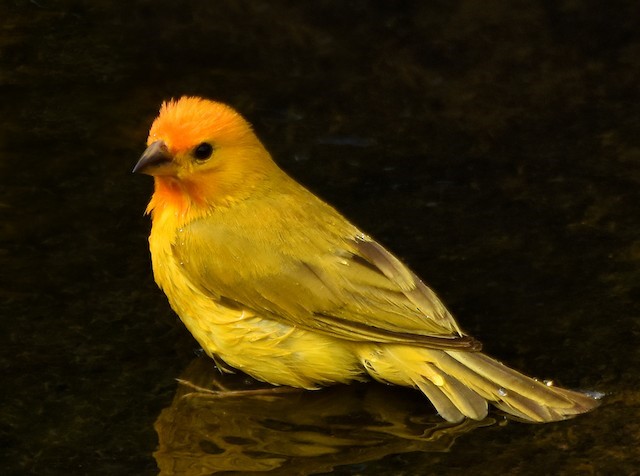Birdfinding.info ⇒ The northern, typical form of Saffron Finch is common and conspicuous in cities, towns, and farmland throughout most of its range. Especially numerous in northern and central Colombia and northern Venezuela. In the Caribbean, introduced populations are common on Bonaire and Curaçao, and in Panama City, and local or uncommon on Puerto Rico and Jamaica. The introduced Hawaiian population is abundant in lowlands of the Big Island, locally common on Oahu (e.g., Waikiki and West Loch), and scarce on Kauai (mainly around Waimea). (For the southern, sexually dimorphic form, see “Pelzeln’s Yellow-Finch”.)
Saffron Finch
Sicalis flaveola
Grasslands and brushlands of South America. Often occurs in developed habitats, including cities, villages, and agricultural areas.
Comprises two distinct forms which may be best regarded as separate species:
“Saffron Finch” (flaveola): the more typical form (in which sexes are similar) consists of three geographically separated subspecies: flaveola, valida, and brasiliensis, found respectively in the northern, western, and eastern tropical regions of South America—this form is discussed in more detail below.
“Pelzeln’s Yellow-Finch” (pelzelni): of central and southern South America, plus koenigi of the eastern Andes—this form is discussed separately in more detail here.

Approximate distribution of Saffron Finch, including “Pelzeln’s Yellow-Finch”. © BirdLife International 2018
In the north, flaveola occupies the Caribbean and central lowlands of Colombia and Venezuela—including the Cauca and Magdalena River valleys, the Llanos of both countries, and Isla Margarita—east into Guyana and Trinidad, and south into Roraima. From the Colombian Llanos, it has spread into eastern Ecuador, and from the Cauca Valley to the Pacific slope (both apparently due to deforestation).
Introduced populations of flaveola are established in several nearby areas, including the ABC Islands, central Panama, Quito, Lima, and elsewhere in the Andes and Amazon Basin of Ecuador and Peru (southeast to Puerto Maldonado), and likely also into Amazonian Brazil (Acre, Rondônia, northern Mato Grosso, and Manaus). More distant, insular populations are established on Jamaica, Puerto Rico, and Hawaii (the Big Island, Oahu, and more tenuously on Kauai).
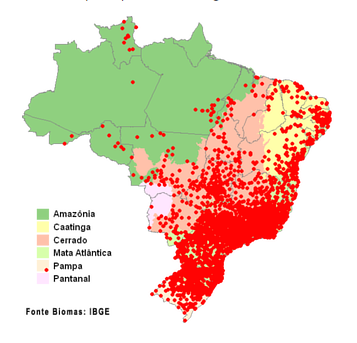
Brazilian records of Saffron Finch, including “Pelzeln’s Yellow-Finch”, by municipality. © WikiAves 2021
West of the Andes, valida inhabits coastal lowlands of Ecuador and northwestern Peru, from Esmeraldas south to Ancash. These populations are spreading north into southwestern Colombia and locally inland to middle elevations of the Andes—where they may be merging into introduced populations of flaveola.
In the east, brasiliensis occupies eastern Brazil from northern Maranhão and southeastern Pará south to coastal São Paulo and Rio de Janeiro. Across central and southeastern Brazil, brasiliensis overlaps broadly with “Pelzeln’s Yellow-Finch” (pelzelni), and the relationship between the two forms is unclear. They appear to occur side-by-side—and may interbreed freely (this seems likely but apparently is not well-documented)—over a zone of blended populations between pure pelzelni in the southwest and pure brasiliensis in the northeast. As a result, it is difficult to determine where the southwestern boundary of brasiliensis’s distribution lies. The zone of overlap extends approximately from eastern Goiás south through westernmost Minas Gerais and eastern São Paulo, then bends east to Rio de Janeiro.
Identification
A widely familiar all-yellow finch that is popularly known as a “canary”—because it happens to resemble the unrelated Atlantic Canary, which originated the name.

Saffron Finch, S. f. flaveola, male. (Pereira, Risaralda, Colombia; July 5, 2018.) © David Monroy Rengifo
The typical male “Saffron Finch” (i.e., flaveola, valida, and brasiliensis) is the yellowest of the Sicalis yellow-finches. It is yellow overall, usually with some orange on the face and forecrown, and olive on the back, wings and tail. Some show faint streaks on the back.

Saffron Finch, S. f. flaveola, male. (Ceiba, Puerto Rico; April 15, 2017.) © José Santiago
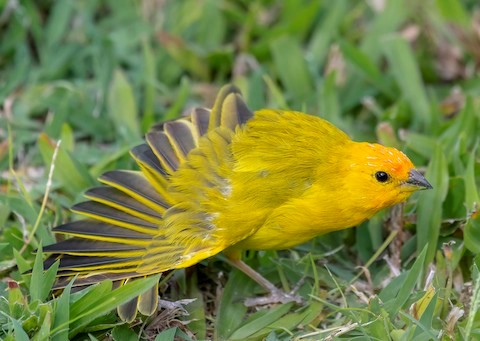
Saffron Finch, S. f. flaveola, male. (Keauhou Bay, Big Island, Hawaii; December 11, 2019.) © William Richards
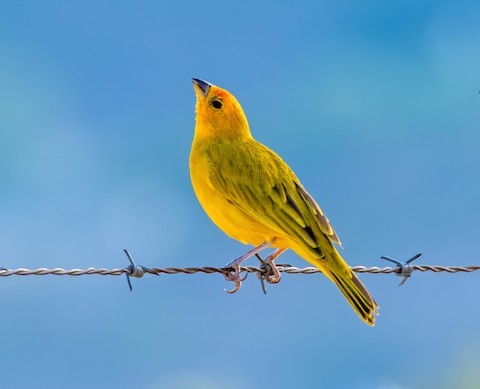
Saffron Finch, S. f. valida, male. (Catamayo, Loja, Ecuador; July 28, 2019.) © Vayun Tiwari
“Pelzeln’s Yellow-Finch”. Male “Pelzen’s” is similar to the typical “Saffron” form, but more greenish-olive and distinctly streaked on the back, and faintly streaked on the breast and belly. Its plumage varies regionally: tropical populations are more vividly colored (like typical “Saffron”), whereas temperate zone and montane populations tend to be duller overall, paler yellow below, and grayish-brown on the back, and largely blackish with yellowish-olive tones on the wings and tail.
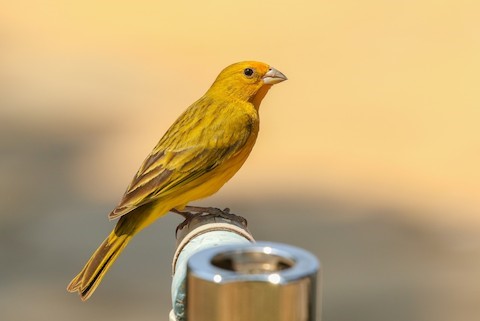
“Pelzeln’s Yellow-Finch”, S. f. pelzelni, male—bright-yellow overall, as is typical of tropical populations. (Porto Jofre, Mato Grosso, Brazil; September 9, 2019.) © Carlos Sanchez

“Pelzeln’s Yellow-Finch”, S. f. koenigi, male showing largely grayish back, typical of the Andean populations. (Cachi, Salta, Argentina; August 26, 2012.) © Marco Valentini
Female Plumages. The typical female “Saffron” resembles the male, but duller yellow and olive, with little or no detectable orange on the face.
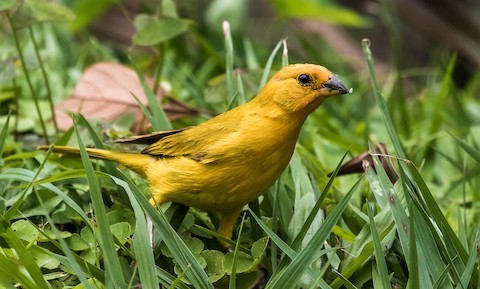
Saffron Finch, S. f. flaveola, female. (Pereira, Risaralda, Colombia; August 10, 2019.) © David Monroy Rengifo
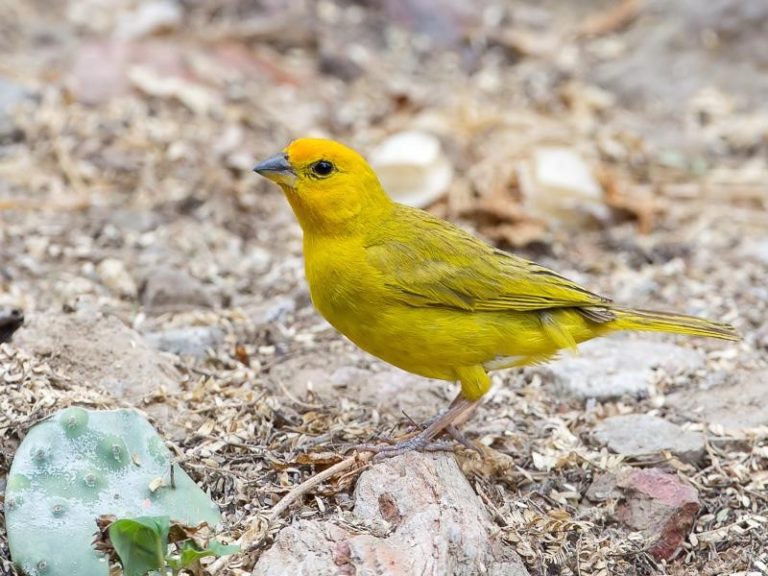
Saffron Finch, S. f. valida, female. (Lambayeque, Peru; June 13, 2015.) © Paul van Giersbergen

Saffron Finch, S. f. valida, female and male. (Parque Samanes, Guayas, Ecuador; January 12, 2018.) © Douglas Faulder
Female “Pelzeln’s” has entirely different plumage: brownish above, whitish below, and streaked throughout.
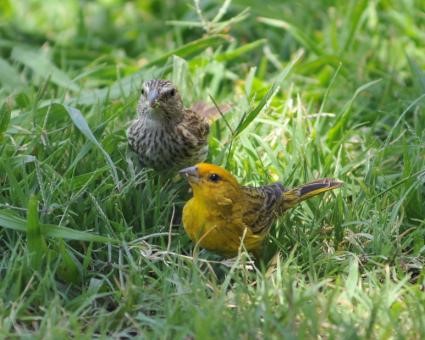
“Pelzeln’s Yellow-Finch”, S. f. pelzelni, female and male—typical of the tropical populations. (San Luís, Argentina; January 29, 2009.) © Santiago Meligeni Lozano

“Pelzeln’s Yellow-Finch”, S. f. pelzelni, female with bold, heavy streaking on the underparts. (40 y 108, Lavalleja, Uruguay; April 3, 2021.) © Amed Hernández
Most females of tropical and subtropical populations are heavily streaked, but the extent and boldness of the streaking vary.
Females of Andean populations tend to be paler overall and less heavily streaked.
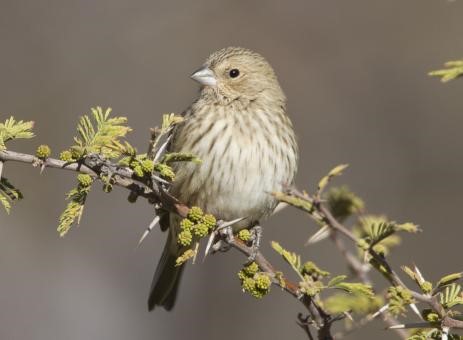
“Pelzeln’s Yellow-Finch”, S. f. koenigi, female with relatively sparse, thin streaking on the underparts. (Seclantás, Salta, Argentina; August 27, 2012.) © Marco Valentini
Immature Plumages. Immature “Saffrons” are pale-gray with bold dark-brown streaks on the upperparts, faint streaks on the underparts, and irregular bright-yellow blotches on the breast, collar, rump, wings, and tail.
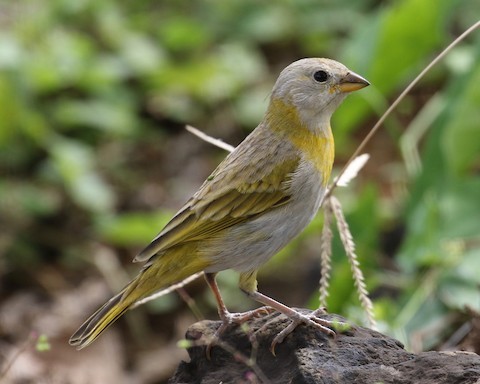
Saffron Finch, S. f. flaveola, immature, showing mostly gray plumage with yellow blotches and staining. (Whittington Beach Park, Big Island, Hawaii; March 16, 2017.) © Laurens Halsey
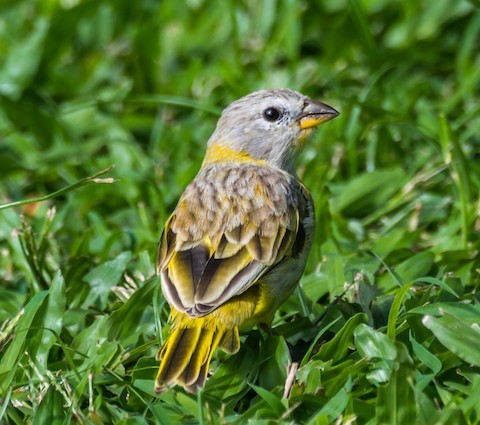
Saffron Finch, S. f. flaveola, immature, showing mostly gray upperparts with yellow blotches and staining. (Isaac Hale Beach Park, Big Island, Hawaii; December 28, 2019.) © Jim Merritt
As they age, the yellow spreads, sometimes erupting unevenly on the belly or elsewhere.
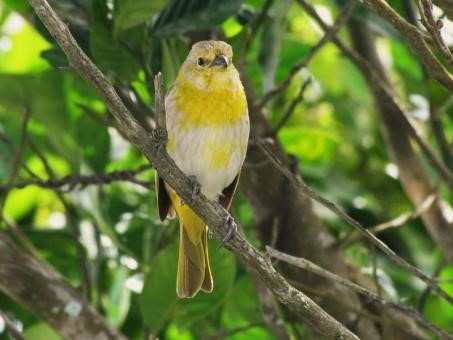
Saffron Finch, S. f. flaveola, immature, showing yellow blotches on the underparts. (Agostini, Trinidad; February 7, 2012.) © Nigel Lallsingh
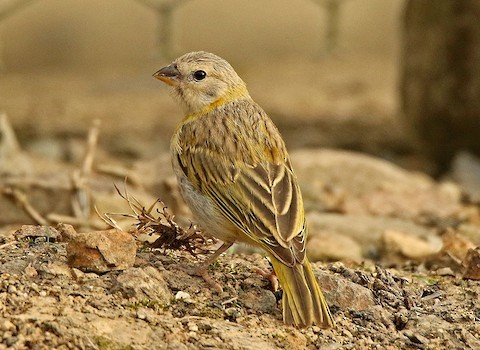
Saffron Finch, S. f. valida, immature, showing streaked upperparts with yellow wash. (La Chonta, Zamora-Chinchipe, Ecuador; June 9, 2018.) © Roger Ahlman
Immature “Pelzeln’s” generally resemble females, so immature and female plumages are not readily distinguishable.
As males age they develop yellow plumage in subtle stages but are not known to show the distinctive pattern of immature “Saffron” (mostly plain-gray with vivid yellow patches).
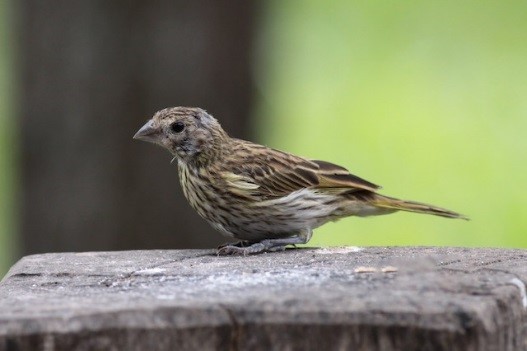
“Pelzeln’s Yellow-Finch”, S. f. pelzelni, juvenile. (Pousada Aguape, Mato Grosso do Sul, Brazil; April 6, 2010.) © Michael Todd
Voice. All forms of Saffron Finch have roughly the same type of song—variable, vigorous ramblings of sweet musical chirps, delivered at length, shifting between single notes and twittering phrases: Its song is highly prized across much of Latin America, which largely accounts for its popularity as a cagebird (the Latin American “canary”), which in turn accounts for its spread as an introduced species.
Notes
Polytypic species consisting of five recognized subspecies, representing two distinct forms: “Saffron Finch” (flaveola plus valida and brasiliensis) of tropical northern, western, and eastern South America, and “Pelzeln’s Yellow-Finch” (pelzelni plus koenigi) of central and southern South America from Bolivia and central Brazil to southern Chile and Argentina.
See below for a discussion of the taxonomic complexity of the Saffron Finch forms and comparison of “Saffron Finch” with Orange-fronted Yellow-Finch.
Frontiers of Taxonomy: The Saffron Finch Complex. “Pelzeln’s Yellow-Finch” (pelzelni plus koenigi) seems to be a strong candidate for recognition as a species separate from the typical “Saffron Finch” (flaveola plus valida and brasiliensis) for the simple reason that “Pelzeln’s” is sexually dimorphic whereas “Saffron” is not. Male “Pelzeln’s” and male and female “Saffron” are all predominantly yellow and often too similar to differentiate visually, but female “Pelzeln’s” is radically different: plain gray and brown and heavily streaked. The two forms also differ in their climatic tolerances: all three subspecies of “Saffron” are exclusively tropical, whereas “Pelzeln’s” thrives from the tropics to approximately 42° South in Argentina and Chile and up to at least 3,100 m elevation in the Andes.
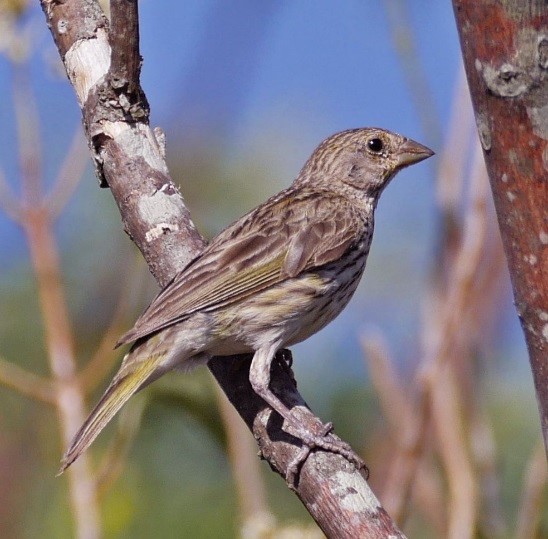
“Pelzeln’s Yellow-Finch”, S. f. pelzelni, female (or possibly an immature) showing typically plain gray-and-brown streaked appearance—entirely unlike female “Saffron”. (San Jerónimo Norte, Santa Fé, Argentina; January 21, 2018.) © Gustavo Fernando Durán
However, their songs are very similar, perhaps identical, which might make males of “Saffron” and “Pelzeln’s” equivalent as prospective mates for females of either form. Across central and southeastern Brazil, “Pelzeln’s” and “Saffron” overlap broadly across the cerrado region from Goiás to Rio de Janeiro, and in that broad zone of cohabitation the relationship between their populations is not clear. The existence of apparently intermediate individuals suggests interbreeding—which may be widespread enough to conclude that the two apparently distinct forms function naturally as a single species.
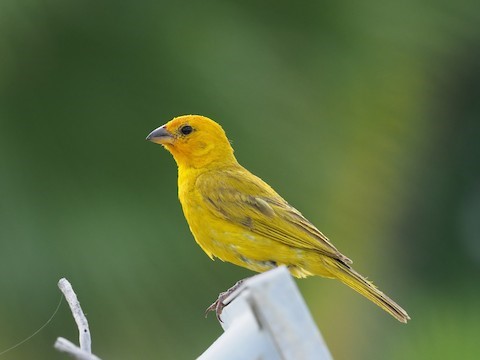
Saffron Finch, S. f. flaveola, an apparent female—which strongly resembles male “Saffron” and “Pelzeln’s”. (Saliña Bartol, Washington Slagbaai National Park, Bonaire; November 18, 2018.) © Lyle Ross
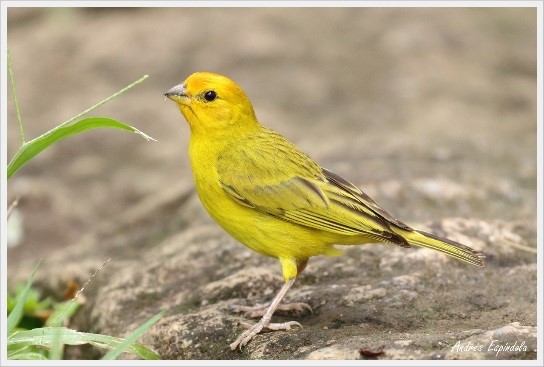
Saffron Finch, S. f. brasiliensis, an apparent female—in the zone of overlap with “Pelzeln’s Yellow-Finch”, S. f. pelzelni—and could possibly be a male pelzelni. (Parati, Rio de Janeiro, Brazil; January 29, 2018.) © Andres Espindola

Saffron Finch, S. f. brasiliensis, an apparent male—based on the amount of orange on the head. (Fazenda Porangaí, Xinguara, Pará, Brazil; September 15, 2018.) © Luiz Matos
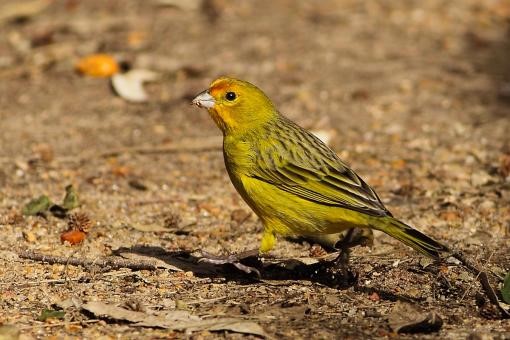
“Pelzeln’s Yellow-Finch”, S. f. pelzelni, male showing vivid plumage, with stronger streaking than typical “Saffron” males. (El Palmar National Park, Entre Ríos, Argentina; July 28, 2014.) © Cristiano Crolle
To begin, at least two factors make the evidence of interbreeding difficult to evaluate: (1) male “Pelzeln’s” strongly resembles male “Saffron” in appearance and voice and can be visually indistinguishable from the female “Saffron”, so conclusive identification of “Saffron” requires field study of groups, and is rarely possible based on photographs alone; and (2) “Pelzeln’s” varies regionally, with a progression from vivid plumage in tropical populations to plainer, grayer, and streakier plumage in temperate and montane populations, so the “Pelzeln’s” that are most similar to “Saffron” are the ones that overlap with it.
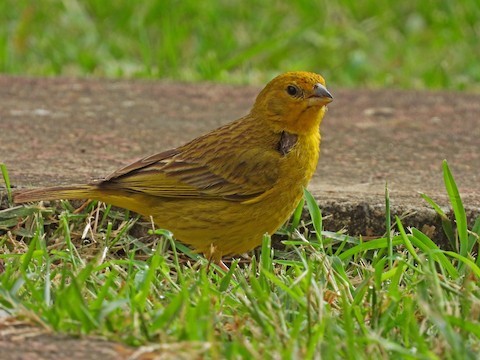
“Pelzeln’s Yellow-Finch”, S. f. pelzelni, male—in the zone of overlap with “Saffron Finch”, S. f. brasiliensis—note the streaking above and below, which seems to rule out brasiliensis. (Brasília, Brazil; May 9, 2020.) © Edvaldo Júnior
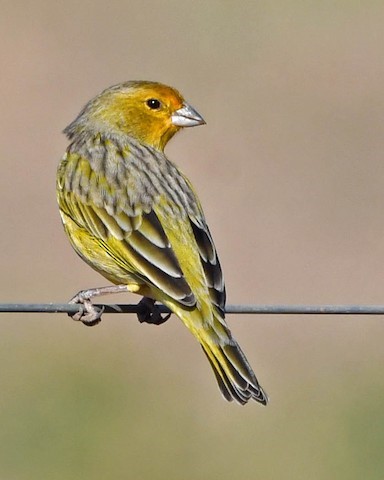
“Pelzeln’s Yellow-Finch”, S. f. koenigi, male showing largely grayish, heavily streaked back, typical of the Andean populations—“Pelzeln’s” varies regionally on a spectrum from Saffron-like yellow in the tropics to gray and heavily streaked in montane and temperate areas. (El Breal, Tarija, Bolivia; July 11, 2021.) © Tini & Jacob Wijpkema

“Pelzeln’s Yellow-Finch”, S. f. pelzelni, male in bright plumage. (Laguna Nahuel Ruca, Mar Chiquita, Buenos Aires, Argentina; October 17, 2020.) © Claudio Rodriguez
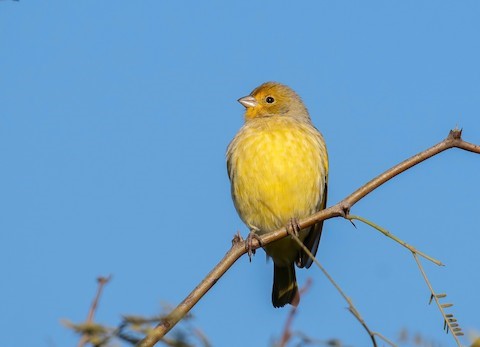
“Pelzeln’s Yellow-Finch”, S. f. pelzelni, male in relatively plain plumage typical of Andean and temperate zone populations. (Las Colonias, Santa Fe, Argentina; May 1, 2021.) © Calidris Esperanza
The latter factor is itself prima facie evidence of genetic exchange over many generations. That is, an obvious candidate explanation for the progression that the adjacent pelzelni populations are more blended with brasiliensis and the more distant ones are progressively more distinct. This in turn would tend to suggest that the two forms were geographically separated for many generations, long enough to diverge substantially through genetic drift, then re-encountered one another soon enough that they readily interbreed and are gradually reintegrating. If this is accurate, then most taxonomists would maintain their current classification as a single species. This consensus seems appropriate, pending the emergence of any potentially conflicting evidence.
Cf. Orange-fronted Yellow-Finch. Saffron Finches of both sexes and male Orange-fronted Yellow-Finch are very similar and easily confused where they overlap (and often flock together): in the Llanos, interior eastern Brazil, and central Amazonia (where Saffron has been introduced). Both are predominantly vivid yellow with some orange in the face, but Orange-fronted has a specific and distinctive facial pattern that includes blackish lores (sometimes extending behind the eye as an eyeline or partial mask) and a discrete orange patch on the forecrown. Saffron’s facial pattern is more variable and less distinct—usually yellow overall, shading to orange on the forehead and lores.
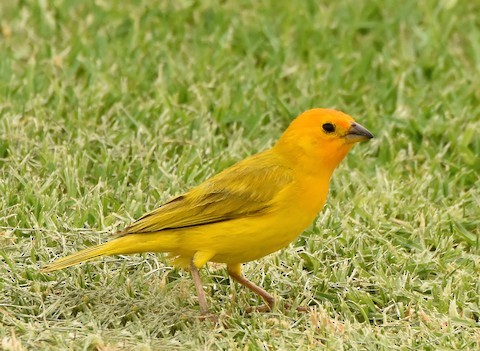
Saffron Finch, S. f. flaveola, male showing typically yellow-orange lores. (Waikoloa Village Golf Club, Big Island, Hawaii; July 30, 2015.) © Steven Mlodinow

Orange-fronted Yellow-Finch, male with minimally dark lores—yet still noticeably duskier than on Saffron. (Santarém, Pará, Brazil; January 6, 2012.) © Valdir Hobus
Structurally, Orange-fronted is somewhat smaller than Saffron, which is noticeable when they occur side-by-side, and the bills differ: Saffron’s is darker, shorter, and blunter, whereas Orange-fronted’s is paler, longer, and sharper-tipped. Typical leg color differs as well: Saffron’s legs tend to be grayish, whereas Orange-fronted’s tend to be pale pink. Bill and leg color vary somewhat in both species, so they are sometimes strongly indicative but not usually diagnostic.
Female and immature plumages differ significantly. Female Orange-fronted is mostly plain-gray with olive wings and tail, unlike any plumage of Saffron. Immature Orange-fronted is unstreaked and variably grayish, olive, or yellowish, whereas immature Saffron tends to show irregular bright-yellow blotches.

Saffron Finch, S. f. flaveola, immature, showing largely gray plumage with streaked upperparts and blotchy yellow wash. (Dorado, Puerto Rico; September 2, 2013.) © Ernesto Burgos
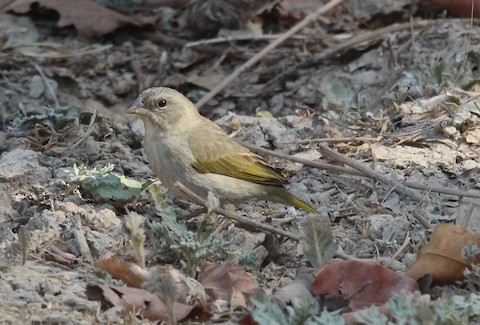
Orange-fronted Yellow-Finch, female showing typical unmarked gray plumage with olive wings and tail. (Hato La Aurora, Casanare, Colombia; February 27, 2019.) © Paul van Els

Orange-fronted Yellow-Finch, immature showing grayish plumage with olive and yellow wash. (Ilha Nova, Careiro da Várzea, Amazonas, Brazil; May 30, 2018.) © Luiz Moschini
The maximum potential for confusion is between the female Saffron and subadult male Orange-fronted—both of which typically show little or no orange on the face or forecrown. For such ambiguous individuals, consistent distinctions appear to be Orange-fronted’s dark lores and paler, longer, sharper bill.

Orange-fronted Yellow-Finch, an apparent subadult male with an indistinct facial pattern—but note that the lores are not yellow. (Hato El Cedral, Apure, Venezuela; December 18, 2012.) © Karla Perez Leon

Saffron Finch, S. f. brasiliensis, sex indeterminate but plumage seems more consistent with female (or relatively plain male)—note yellow lores and faint streaking on the back. (Marabá, Pará, Brazil; July 3, 2021.) © Luiz Matos
Additional Photos of Saffron Finch

Saffron Finch, S. f. brasiliensis, male. (Serra da Canastra National Park, Minas Gerais, Brazil; September 14, 2010.) © Frédéric Pelsy
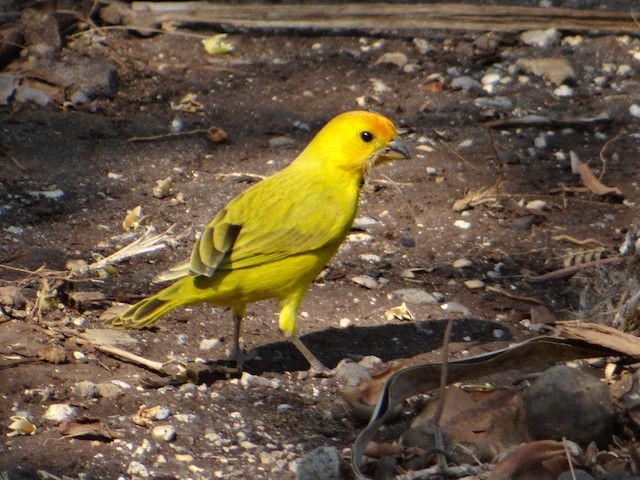
Saffron Finch, S. f. flaveola. (Pu’ukohola Heiau National Historic Site, Big Island, Hawaii; January 19, 2017.) © Kas Dumroese
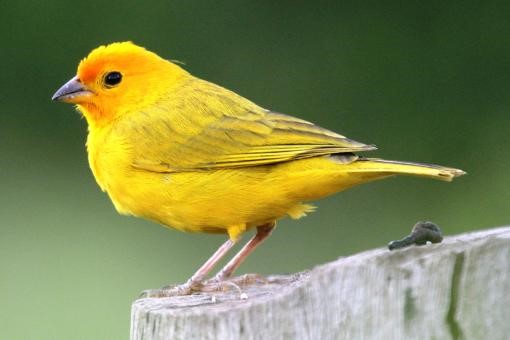
Saffron Finch, S. f. flaveola, male. (Apulo, Cundinamarca, Colombia; November 6, 2011.) © Mauricio Rueda
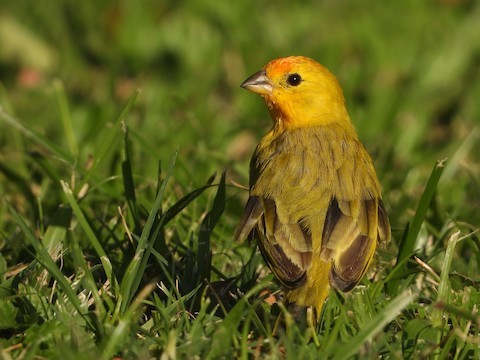
Saffron Finch, S. f. flaveola, male. (Waiau District Park, Waimalu, Oahu, Hawaii; February 12, 2020.) © Kellen Apuna
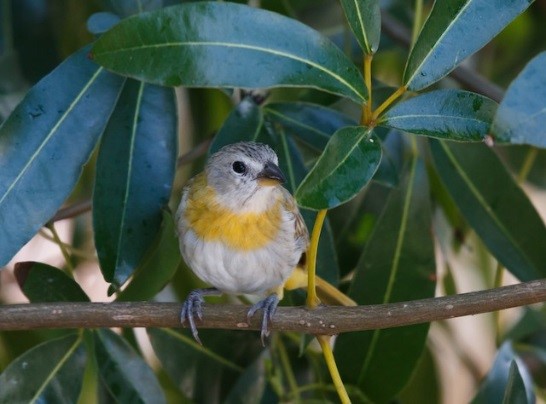
Saffron Finch, S. f. flaveola, immature, showing blotchy yellow chest collar. (Parque Luis Muñoz Rivera, San Juan, Puerto Rico; February 13, 2016.) © Simon Best

Saffron Finch, S. f. flaveola, subadult with traces of immature gray plumage on the underparts. (Mondesir, Siparia, Trinidad; January 15, 2018.) © Tarran Maharaj
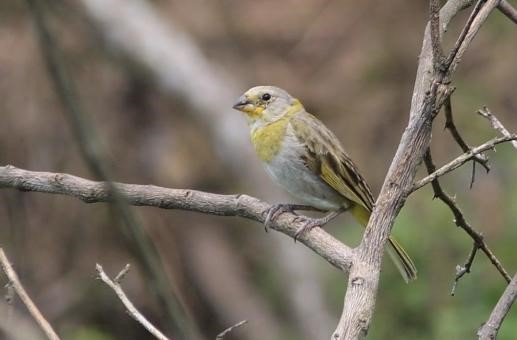
Saffron Finch, S. f. flaveola, immature, showing blotchy yellow chest collar. (Tucupido Reservoir, Portuguesa, Venezuela; August 23, 2014.) © Eduardo Freitez Gassan
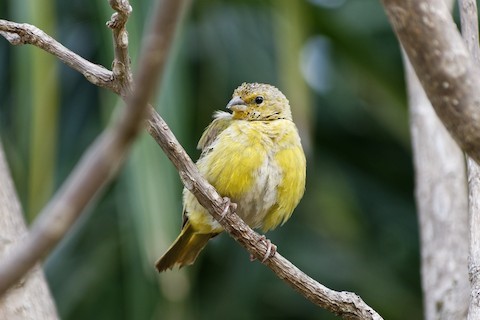
Saffron Finch, S. f. brasiliensis, immature with blotchy yellow wash on the underparts—however, the details in this photo do not rule out immature Orange-fronted (the dark lores suggest Orange-fronted, but the bill shape is more typical of Saffron). (Parque das Garças, Brasília, Brazil; May 23, 2021.) © Andre Viana
References
Ascanio, D., G.A. Rodriguez, and R. Restall. 2017. Birds of Venezuela. Christopher Helm, London.
Aves de Chile. 2021. Chirihue Azafrán. https://www.avesdechile.cl/480.htm. (Accessed September 17, 2021.)
BirdLife International. 2018. Sicalis flaveola. The IUCN Red List of Threatened Species 2018: e.T22723346A132162254. https://dx.doi.org/10.2305/IUCN.UK.2018-2.RLTS.T22723346A132162254.en. (Accessed September 26, 2021.)
de la Peña, M.R., and M. Rumboll. 1998. Birds of Southern South America and Antarctica. Princeton University Press.
eBird. 2021. eBird: An online database of bird distribution and abundance. Cornell Lab of Ornithology, Ithaca, N.Y. http://www.ebird.org. (Accessed September 26, 2021.)
ffrench, R. 2012. A Guide to the Birds of Trinidad & Tobago (Third Edition). Cornell University Press.
Haynes-Sutton, A., A. Downer, R. Sutton, and Y.-J. Rey-Millet. 1986. A Photographic Guide to the Birds of Jamaica. Princeton University Press.
Kirwan, G.M., A. Levesque, M. Oberle, and C.J. Sharpe. 2019. Birds of the West Indies. Lynx Edicions, Barcelona.
Martínez Piña, D.E., and G.E. González Cifuentes. 2021. Field Guide to the Birds of Chile. Princeton University Press.
McMullan, M., and T. Donegan. 2014, Field Guide to the Birds of Colombia (Second Edition). Fundación Proaves de Colombia, Bogotá.
Pyle, R.L., and P. Pyle. 2017. The Birds of the Hawaiian Islands: Occurrence, History, Distribution, and Status. Version 2 (January 1, 2017). http://hbs.bishopmuseum.org/birds/rlp-monograph/. B.P. Bishop Museum, Honolulu, Hawaii.
Raffaele, H. 1989. A Guide to the Birds of Puerto Rico and the Virgin Islands. Princeton University Press.
Raffaele, H., J. Wiley, O. Garrido, A. Keith, and J. Raffaele. 1998. A Guide to the Birds of the West Indies. Princeton University Press.
Ridgely, R.S., and P.J. Greenfield. 2001. The Birds of Ecuador, Volume II: Field Guide. Cornell University Press.
Ridgely, R.S., and J.A. Gwynne. 1989. A Guide to the Birds of Panama (Second Edition). Princeton University Press.
Ridgely, R.S., and G. Tudor. 1989. The Birds of South America, Volume I: The Oscine Passerines. University of Texas Press, Austin.
Ridgely, R.S., and G. Tudor. 2009. Field Guide to the Songbirds of South America: The Passerines. University of Texas Press.
Schulenberg, T.S., D.F. Stotz, D.F. Lane, J.P. O’Neill, and T.A. Parker. 2007. Birds of Peru. Princeton University Press.
van Perlo, B. 2009. A Field Guide to the Birds of Brazil. Oxford University Press, Oxford.
Wells, J.V., and A.C. Wells. 2017. Birds of Aruba, Bonaire, and Curaçao. Cornell University Press.
Wikiaves. 2021. Canário-da-terra, http://www.wikiaves.com.br/canario-da-terra. (Accessed September 26, 2021.)
Xeno-Canto. 2021. Saffron Finch – Sicalis flaveola. https://www.xeno-canto.org/species/Sicalis-flaveola. (Accessed September 26, 2021.)
